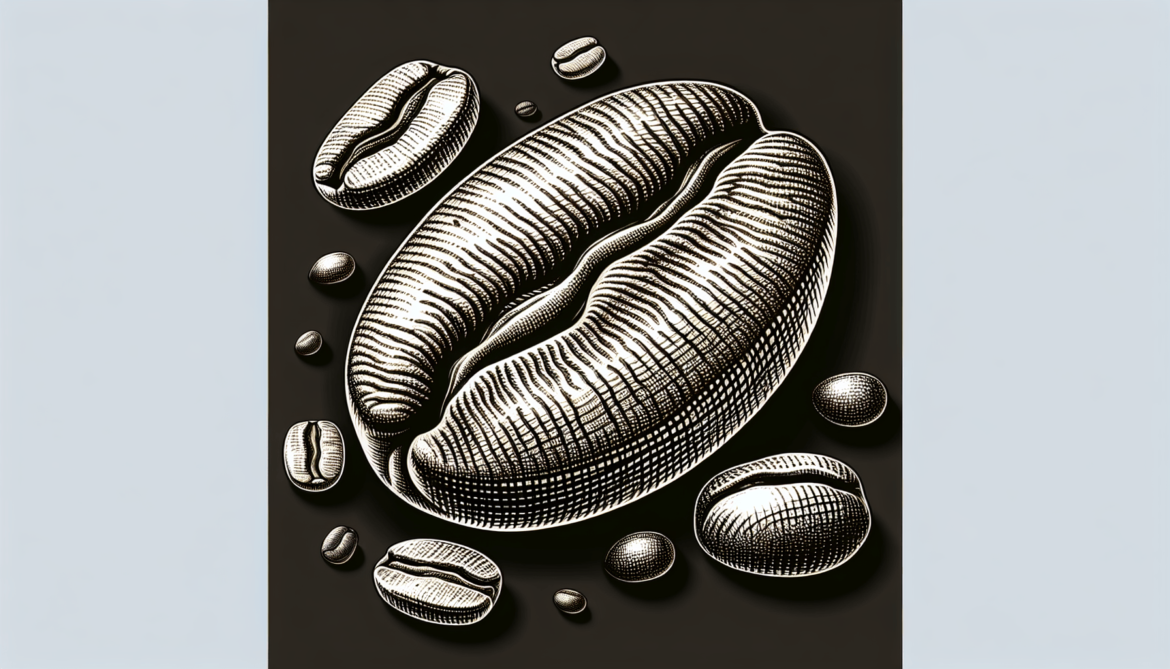Are you a coffee enthusiast looking to explore the diverse world of coffee beans? Look no further! This comprehensive guide will introduce you to different types of coffee beans, allowing you to awaken your taste buds and discover new flavors. From the rich and intense flavors of Robusta beans to the delicate and nuanced profiles of Arabica beans, this article will provide you with all the information you need to navigate the world of coffee and enhance your daily brewing experience. So grab your favorite mug and get ready to embark on a flavorful journey through the world of coffee bean types.
Arabica Coffee Beans
Arabica coffee beans are one of the most popular types of coffee beans in the world. They have their origin in the highlands of Ethiopia, where they were first discovered and cultivated. Arabica beans are known for their delicate and nuanced flavors, making them highly sought after by coffee connoisseurs.
Arabica beans are characterized by their vibrant acidity, smooth body, and sweet, floral notes. They often exhibit flavors of chocolate, caramel, and fruit, making them a perfect choice for those who enjoy a more complex and flavorful cup of coffee. Additionally, Arabica beans have lower caffeine content compared to other varieties, which makes them a great choice for those who are sensitive to caffeine.
These beans require specific growing conditions to thrive. They are typically grown at high altitudes, ranging from 2,000 to 6,000 feet above sea level. The cool temperatures and shorter growing seasons at these higher elevations contribute to the unique flavors and characteristics of Arabica beans. They are also more susceptible to diseases and pests, which makes their cultivation more labor-intensive and challenging.
Some popular varieties of Arabica beans include Ethiopian Yirgacheffe, Colombian Supremo, and Brazilian Bourbon Santos. Each variety offers its own distinct flavor profile, influenced by factors such as growing region, soil composition, and processing techniques. Arabica beans are widely available and can be found in various forms, including whole beans, ground coffee, and instant coffee.
Robusta Coffee Beans
Robusta coffee beans, as the name suggests, are known for their strong and robust flavors. They have their origin in central and western Africa, where they were originally cultivated. Unlike Arabica beans, Robusta beans are less delicate and have a more straightforward taste profile.
Robusta beans are characterized by their higher caffeine content, making them a popular choice for those who prefer a strong and energizing cup of coffee. They are often described as having a full-bodied and bitter taste, with hints of chocolate and nuts. Due to their robust flavors, Robusta beans are commonly used in espresso blends to add depth and a lingering aftertaste.
Growing conditions for Robusta beans are less demanding compared to Arabica beans. They thrive in lowland regions and are better adapted to withstand diseases and pests. Robusta plants are also more resistant to extreme weather conditions, such as drought and high temperatures. These factors make Robusta beans a more cost-effective option for coffee growers.
Robusta beans are often blended with Arabica beans to create a well-rounded and balanced cup of coffee. The addition of Robusta beans adds body, crema, and a kick of caffeine to the blend. However, it is important to note that not all Robusta beans are of the same quality. Premium Robusta beans, such as those from India and Vietnam, exhibit better flavor profiles and are highly regarded in the coffee industry.
Liberica Coffee Beans
Liberica coffee beans are unique and less common compared to Arabica and Robusta beans. They have their origin in West and Central Africa, but their cultivation is now primarily concentrated in Southeast Asia. Liberica beans are distinct in appearance, with larger and asymmetrical shapes.
Characteristics of Liberica beans include a bold and smoky flavor profile. They are often described as having a full-bodied taste, with notes of dark chocolate, wood, and even floral undertones. Due to their unique flavor profile, Liberica beans are gaining popularity among specialty coffee enthusiasts who enjoy experimenting with different and unconventional tastes.
Availability of Liberica beans is more limited compared to Arabica and Robusta beans. They are grown in smaller quantities and are often considered a rarity in the coffee industry. However, with the increasing demand for unique and exotic flavors, Liberica beans have gained attention and can be found in specialty coffee shops and online retailers.
Traditionally, Liberica beans were used for blending purposes, adding depth and complexity to coffee blends. However, in recent years, there has been a growing interest in showcasing the specific flavors of Liberica beans through single-origin offerings. This allows coffee lovers to appreciate the distinct characteristics of Liberica coffee and explore its potential in various brewing methods.
Excelsa Coffee Beans
Excelsa coffee beans are a lesser-known variety that falls under the category of “Coffea liberica” species. These beans originated in Southeast Asia and are primarily grown in countries such as Vietnam and the Philippines. Excelsa beans are characterized by their unique flavor profile and qualities.
The flavor profile of Excelsa beans is often described as bold and fruity. They offer a unique combination of tartness and sweetness, with hints of dark fruit and floral notes. The taste of Excelsa coffee is often compared to that of a dark cherry or a blend of dark berries. This distinct flavor profile makes Excelsa beans a great choice for those who enjoy a more adventurous and complex coffee experience.
What sets Excelsa beans apart is their versatility. Unlike other coffee varieties, Excelsa beans can be used not only for brewing coffee but also for other purposes. One alternative use is incorporating Excelsa beans into desserts and dishes to add a rich and aromatic flavor. The unique qualities of Excelsa coffee make it a versatile ingredient that can enhance a wide range of culinary creations.
While Excelsa beans may not be as widely available as Arabica or Robusta beans, they can be found in specialty coffee shops and online retailers. Their limited availability adds to their allure and makes them a treasure for coffee enthusiasts seeking something out of the ordinary.
Geisha Coffee Beans
Geisha coffee beans, also known as Gesha beans, have gained significant recognition in the specialty coffee world. They have their origin in the highlands of Ethiopia but are now primarily cultivated in Panama. Geisha beans are known for their exceptional quality and unique flavor profile.
Characteristics of Geisha beans include a delicate and tea-like acidity, with a smooth and silky body. They offer a complex flavor profile, combining floral and fruity notes. Tasting Geisha coffee is often an experience of exploring nuances of jasmine, bergamot, tropical fruits, and even hints of bergamot. This intricate flavor profile has captivated coffee enthusiasts worldwide and has become a benchmark for excellence in specialty coffee.
Growing conditions play a crucial role in the development of Geisha beans’ unique flavors. They thrive in high-altitude regions with cool temperatures, providing the optimal environment for the beans to mature slowly and develop their distinct qualities. The meticulously controlled growing conditions in Panama contribute to the exceptional quality of Geisha coffee.
Acclaimed varieties of Geisha beans include the Panamanian Geisha and the Ethiopian Geisha. The Panamanian Geisha has gained legendary status and has earned high auction prices due to its exceptional flavor profile. On the other hand, the Ethiopian Geisha, being closer to its original roots, showcases more traditional Ethiopian flavor characteristics.
Geisha coffee is highly sought after and is often sold at a premium price. This rarity and exclusivity have made Geisha beans a symbol of luxury and prestige among coffee enthusiasts. It is a true delicacy that offers a one-of-a-kind coffee experience.
Typica Coffee Beans
Typica coffee beans are one of the original varieties of coffee and have their origin in Yemen. They are the parent plant of many other coffee varieties, including Bourbon and Caturra. Typica beans are known for their delicate flavors and have played a significant role in shaping the coffee industry.
Characteristics of Typica beans include a mild and smooth flavor profile, with low acidity and subtle sweetness. They are often described as having a well-balanced and pleasant taste, making them a favorite of those who prefer a more straightforward and classic cup of coffee. Typica beans can exhibit flavors of caramel, nuts, and even spices.
Typica beans have regional variations in flavor due to their adaptation to different growing conditions. For example, Ethiopian Typica offers a distinct flavor profile with fruity and floral notes, while Jamaican Typica showcases a more balanced and mellow taste. These regional variations add to the diversity of Typica coffee and offer coffee lovers a chance to explore different flavor profiles.
Cultivation challenges are associated with Typica beans, as they are susceptible to diseases and pests. Additionally, Typica plants are not as productive as other coffee varieties, resulting in lower yields. Despite these challenges, Typica beans remain highly valued for their exceptional flavors and their historical significance in the coffee industry.
Maragogype Coffee Beans
Maragogype coffee beans, also known as “elephant beans,” are a unique variety that stands out due to their exceptionally large size. They have their origin in Brazil but have spread to other coffee-growing regions as well. Maragogype beans are less common than other varieties but are treasured for their distinct characteristics.
Characteristics of Maragogype beans include a smooth and mild flavor profile, with a soft acidity and a slightly nutty sweetness. They are often described as having a well-rounded taste, with hints of chocolate and caramel. Despite their size, Maragogype beans offer a delicate and balanced cup of coffee.
The large size of Maragogype beans contributes to their visual appeal and creates a unique brewing experience. Due to their size, they require specific brewing recommendations to ensure proper extraction and to optimize flavor. It is recommended to use a coarser grind size and adjust brewing parameters accordingly to prevent over-extraction and maintain the delicate flavors of Maragogype coffee.
Despite their unique characteristics, Maragogype beans have lower productivity compared to other varieties. This limited supply makes them less common and often more expensive than other types of coffee beans. For those seeking a special and visually impressive coffee experience, Maragogype beans are an excellent choice.
Bourbon Coffee Beans
Bourbon coffee beans are named after the island of Bourbon, now known as Réunion, where they were first cultivated. They have their origin in Yemen and are considered one of the oldest coffee varieties. Bourbon beans have played a significant role in shaping the coffee industry and continue to be highly regarded for their exceptional qualities.
Characteristics of Bourbon beans include a sweet and fruity flavor profile, with notes of caramel, berries, and even spices. They often exhibit a bright acidity and a silky, medium body. Bourbon coffee offers a well-balanced and pleasant taste, making it a favorite of many coffee lovers.
Genetic variability is a prominent characteristic of Bourbon coffee, with different sub-varieties showcasing distinct flavor profiles. For example, the Red Bourbon variety is known for its bright acidity and floral notes, while the Yellow Bourbon has a milder acidity and a sweeter taste. This diversity allows coffee enthusiasts to explore the various flavors and find their preferred Bourbon sub-variety.
Bourbon coffee holds significant historical significance, as it played a vital role in the global expansion of the coffee trade. The spread of Bourbon plants to different regions, such as Central and South America, has influenced the coffee industry and contributed to the diverse range of coffee flavors available today. Bourbon beans remain highly valued for their rich heritage and their exceptional taste.
Catimor Coffee Beans
Catimor coffee beans are a hybrid variety resulting from the crossbreeding of Caturra and Timor coffee plants. They were developed by coffee researchers to create a variety with improved disease resistance and commercial viability. Catimor beans have their origin in Portugal and have spread to other coffee-growing countries.
Characteristics of Catimor beans include a bold and intense flavor profile, with high levels of acidity and bitterness. They offer a robust taste, often described as earthy and woody, with hints of nutty flavors. Catimor coffee can be enjoyed by those who appreciate a strong and full-bodied cup of coffee.
One significant advantage of Catimor coffee is its high resistance to various diseases that commonly affect coffee plants, such as Coffee Leaf Rust. This makes Catimor beans an attractive choice for coffee growers as they require less chemical intervention and provide higher yields, ensuring commercial viability.
While Catimor beans may not be as widely recognized as some other varieties, they are gaining popularity in regions where disease pressure is high. The unique flavor characteristics and disease resistance of Catimor coffee make it an excellent choice for sustainable and resilient coffee cultivation.
Mocha Coffee Beans
Mocha coffee beans have their origin in Yemen, specifically in the region of Mocha, which was a prominent port for coffee trade in the 15th century. They are often associated with the history and traditions of coffee and have a distinct flavor profile that sets them apart from other varieties.
Characteristics of Mocha beans include a rich and complex flavor profile, with hints of chocolate, spices, and even wine-like notes. Mocha coffee is often described as having a medium body and a vibrant acidity. The unique taste of Mocha beans offers a delightful and memorable coffee experience.
One aspect that sets Mocha beans apart is the traditional processing technique used in their production. Mocha coffee is typically dry-processed, where the cherries are sun-dried with the beans still inside. This method enhances the distinctive flavors of Mocha coffee, resulting in a rich and intense cup of coffee.
The historical significance of Mocha beans is prominent, as they were among the first coffee beans to be exported and enjoyed worldwide. The name “Mocha” is often used to describe coffee with chocolate flavors, further emphasizing its connection to the origins of coffee. Mocha coffee remains a favorite among those who appreciate the history and heritage of coffee.
In conclusion, the world of coffee offers an extensive range of varieties, each with its own origin, characteristics, and flavor profile. From the delicate and nuanced Arabica beans to the strong and robust Robusta beans, there is a coffee variety to suit every taste preference. Exploring the diverse flavors and qualities of different coffee beans can be a delightful journey for coffee enthusiasts. Whether you prefer a smooth and mild cup of Typica coffee or an adventurous and complex Geisha coffee experience, there is a coffee bean out there waiting to be discovered and savored.



